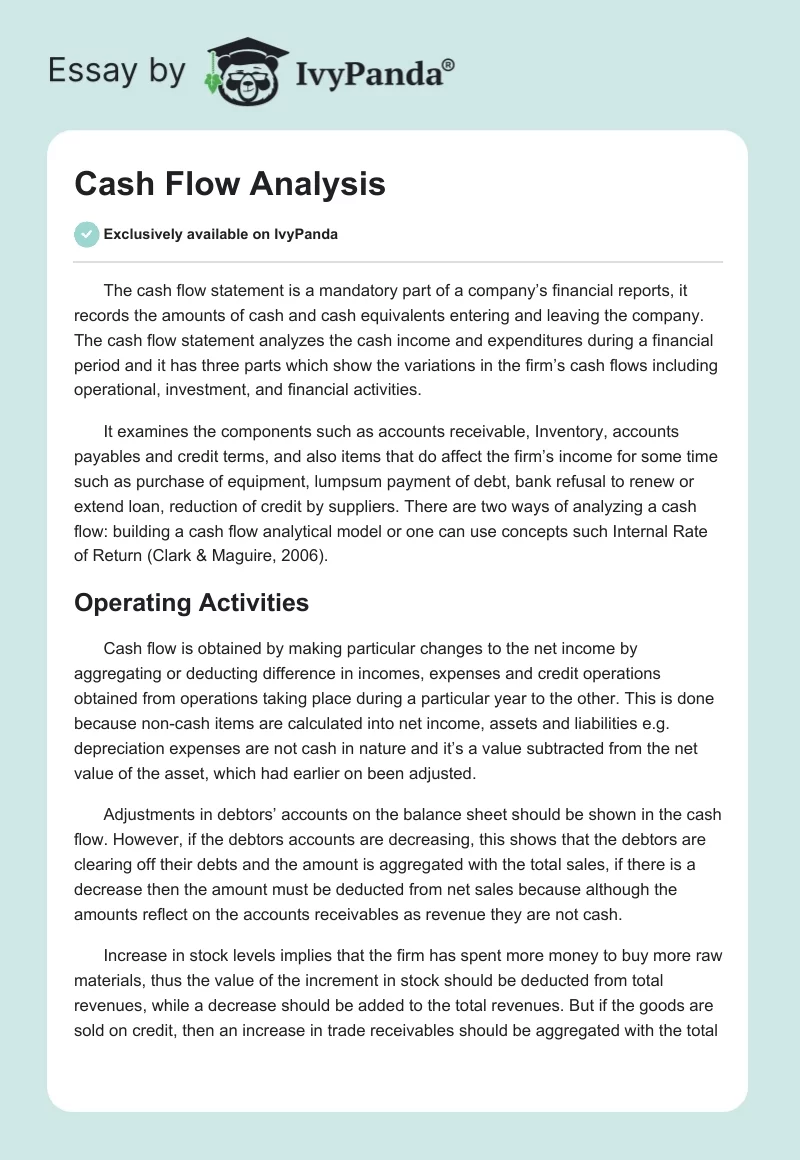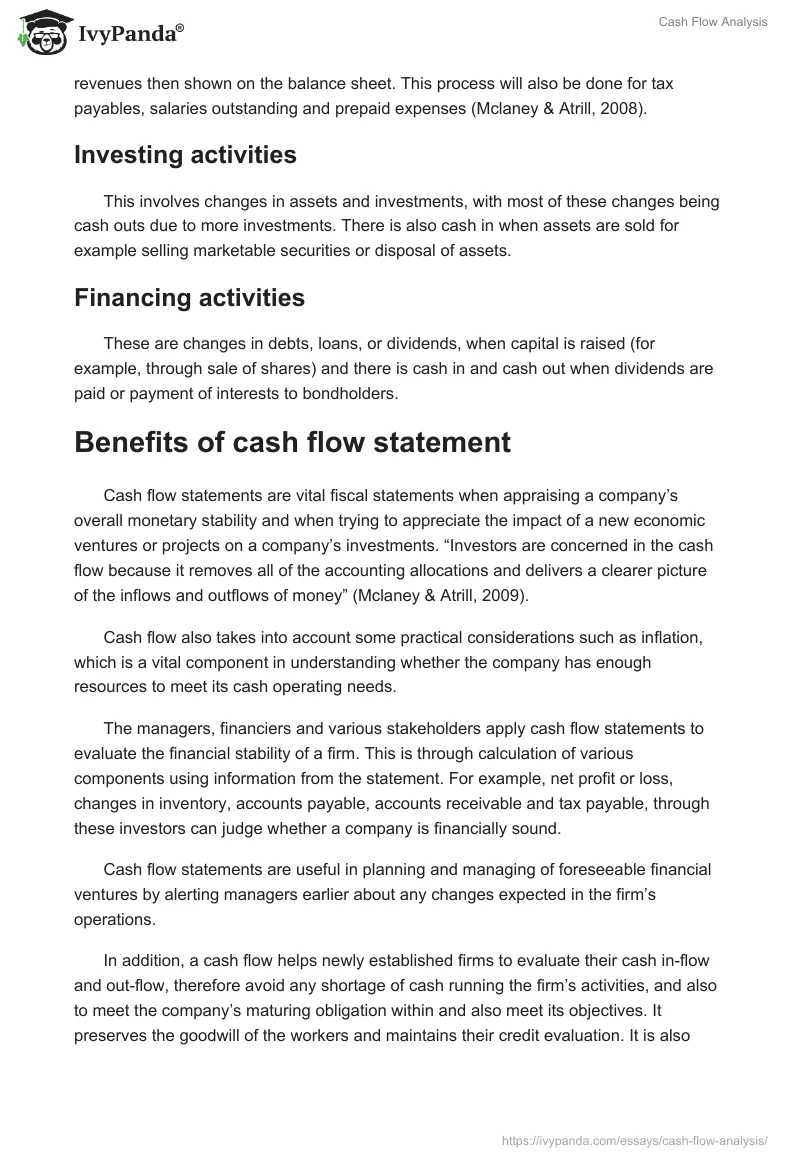Introduction
The cash flow statement is a mandatory part of a company’s financial reports, it records the amounts of cash and cash equivalents entering and leaving the company. The cash flow statement analyzes the cash income and expenditures during a financial period and it has three parts which show the variations in the firm’s cash flows including operational, investment, and financial activities.
It examines the components such as accounts receivable, Inventory, accounts payables and credit terms, and also items that do affect the firm’s income for some time such as purchase of equipment, lumpsum payment of debt, bank refusal to renew or extend loan, reduction of credit by suppliers. There are two ways of analyzing a cash flow: building a cash flow analytical model or one can use concepts such as Internal Rate of Return (Clark & Maguire, 2006).
Cash Flow Activities
Operating Activities
Cash flow is obtained by making particular changes to the net income by aggregating or deducting differences in incomes, expenses and credit operations obtained from operations taking place during a particular year to the other. This is done because non-cash items are calculated into net income, assets and liabilities e.g. depreciation expenses are not cash in nature and it’s a value subtracted from the net value of the asset, which had earlier on been adjusted.
Adjustments in debtors’ accounts on the balance sheet should be shown in the cash flow. However, if the debtor’s accounts are decreasing, this shows that the debtors are clearing off their debts and the amount is aggregated with the total sales, if there is a decrease then the amount must be deducted from net sales because although the amounts reflect on the accounts receivables as revenue they are not cash.
Increase in stock levels implies that the firm has spent more money to buy more raw materials, thus the value of the increment in stock should be deducted from total revenues, while a decrease should be added to the total revenues. But if the goods are sold on credit, then an increase in trade receivables should be aggregated with the total revenues then shown on the balance sheet. This process will also be done for tax payables, salaries outstanding and prepaid expenses (Mclaney & Atrill, 2008).
Investing activities
This involves changes in assets and investments, with most of these changes being cash-outs due to more investments. There is also cash in when assets are sold for example selling marketable securities or disposal of assets.
Financing activities
These are changes in debts, loans, or dividends when capital is raised (for example, through sale of shares) and there is cash in and cash out when dividends are paid or payment of interests to bondholders.
Benefits of Cash Flow Statement
Cash flow statements are vital fiscal statements when appraising a company’s overall monetary stability and when trying to appreciate the impact of a new economic ventures or projects on a company’s investments. “Investors are concerned in the cash flow because it removes all of the accounting allocations and delivers a clearer picture of the inflows and outflows of money” (Mclaney & Atrill, 2009).
Inflation
Cash flow also takes into account some practical considerations such as inflation, which is a vital component in understanding whether the company has enough resources to meet its cash operating needs.
Financial Stability
The managers, financiers and various stakeholders apply cash flow statements to evaluate the financial stability of a firm. This is through calculation of various components using information from the statement. For example, net profit or loss, changes in inventory, accounts payable, accounts receivable and tax payable, through these investors can judge whether a company is financially sound.
Planning
Cash flow statements are useful in planning and managing of foreseeable financial ventures by alerting managers earlier about any changes expected in the firm’s operations.
Flow of Revenues
In addition, a cash flow helps newly established firms to evaluate their cash in-flow and out-flow, therefore avoid any shortage of cash running the firm’s activities, and also to meet the company’s maturing obligation within and also meet its objectives. It preserves the goodwill of the workers and maintains their credit evaluation. It is also vital in cases of when the company is seeking additional funds to expand its operations (Atrill & Mclaney, 1994).
A cash flow gives a firm an ascertained flow of revenues no matter the external economic environment, although many corporations prefer a balanced and even inflow and outflow. With the cash flow statement, a firm can calculate a return ratio to ensure that the firm does venture in unforeseeable projects and projects invested in are making good returns.
Conclusion
A cash flow can be exemplified with a balance scale, for instance when an individual measures items, one differentiates the heavier and the lighter, this kind of flow can be shown in the cash flow statement. The cash flow statement indicates the inflow and outflow transactions, thus assisting the investor or the management identify unnecessary expenses, and revenues that are indebted (Atrill & Mclaney, 2008).
An example of a cash flow statement:
Reference List
Atrill, P. & Mclaney, E. (1994). Management accounting: an active learning approach. Malden, MA: Wiley-Blackwell.
Atrill, P. & Mclaney, E. (2008). Financial accounting for decision makers. Denver: CO Prentice Hall.
Clark, M. & Maguire, W. (2006). Business Accounting and Finance in New Zealand. New York: McGraw-Hill.
Mclaney, E, & Atrill, P. (2008). Accounting: an introduction. Denver, CO: Prentice Hall.
Mclaney, E, & Atrill, P (2009). Accounting. Redford, MI: Pearson Education, Limited.


